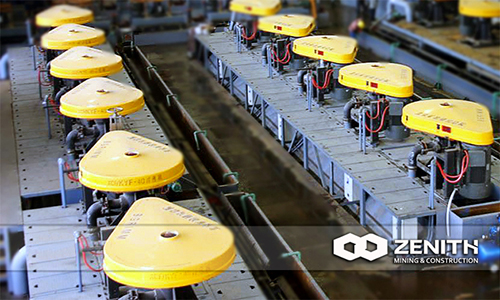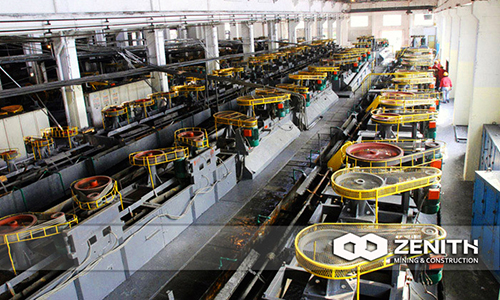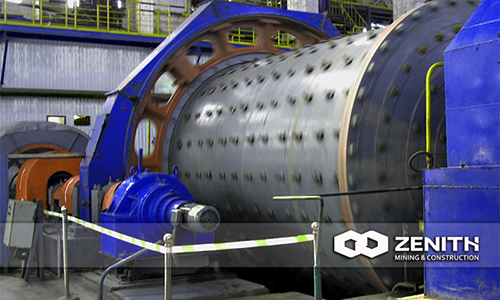Copper is one of the earliest found metals in the human history, its color is amaranth, relative density is 8.89, melting point is 1083°C. Copper and its alloy are good at electric conduction and heat conduction.They have strong resistant to corrosion,and can be processed easily.Considering of these advantages , the copper are widely used in electrical industry,mechanical industry,chemical industry and national defense industry.

1. The brief introduction of manganese ore
All the copper ore can be divided
into the copper sulphide and copper oxide. The copper sulpide ore include the chalcopyrite, chalcocite,
bornite, covellite and malachite; The copper oxide ore contains the malachite, chrysocolla, tenorite,
cuprite. Here is the characteristics of each kind of copper ore as below:
| Name | Content | Density( g/cm3 ) | Color | Theoretical grade | Cutoff grade | Production grade | M Hardness |
| Chalcopyrite | CuFeS2 | 4.1~4.3 | Yellow | 34.5 | ≥0.2-0.3 | ≥0.4-0.5 | 3.5~4..0 |
| Chalcocite | Cu2 S | 5.5~5.8 | Leaden or balck | 79.8 | ≥0.2-0.3 | ≥0.4-0.5 | 2.5~3.0 |
| Bornite | Cu5 FeS 4 | 4.9~5.0 | Copper red or tarnish | 63.3 | ≥0.2-0.3 | ≥0.4-0.5 | 3 |
| Covellite | CuS | 4.6~6.0 | Blue | 66.4 | ≥0.2-0.3 | ≥0.4-0.5 | 1.5~2.0 |
| Malachite | CuCO3 · Cu(OH) 2 | 3.7~4.1 | Green | 57.5 | ≥ 0.5 | ≥ 0.7 | 3.5~4.0 |
| Chrysocolla | CuSiO 3 · 2H 2 O | 2~2.2 | Green | 36.2 | ≥ 0.5 | ≥ 0.7 | 2~4.0 |
| Tenorite | CuO | 5.82~6.25 | Steel grey or Iron Black | 79.85 | ≥ 0.5 | ≥ 0.7 | 3.0~4.0 |
| Cuprite | Cu2 O | 5.8~6.2 | Dark Red | 88.8 | ≥ 0.5 | ≥ 0.7 | 3.5~4.0 |

2. The processing technology for the copper ore:
Copper Sulphide Ore:
a.
Flotation Technology ( Preferential flotation or mixed flotation)
Copper Oxide Ore:
a.
Flotation Technology:(Sulphidizing Flotation Technology, Fatty Acid Flotation Technology or Amine
Flotation Technology)
b. Dump Leaching Techology: ( Acid leaching method or Ammonia leaching
method)
c. Combined Processing Technology: ( Dump Leaching+ Flotation Processing)
For the
sulphide copper ore and sulphured oxide copper ore processing, we can conclude these commonsense as
below:
"I. All the minerals that don't contain iron element,such as chalcocite and
covellite,they have the similar floatability, cyanide and lime restrain them weakly.
II. All the
copper minerals that contain iron element,such as chalcopyrite and bornite ,when they are in the
alkalescent medium,the cyanide and lime cyanide their flotation.
III. Because xanthate series
collector is anion, it mainly react chemisorption with the Cu ion,so the minerals that contains more Cu
ion will have stronger reaction with xanthate. "
Preferential flotation
This method
first select copper and then get the sulphur concentrate. The collector can be xanthate or together with
the aero float. For the compact nubby iron pyrite which contains copper, the flotation reaction should
be in the strongbasicitic medium (PH=11~12)when select copper, it can restrain vast iron pyrite,at the
same time,we should control CaO is about 700~1000g/L.when it contains litter vast iron, we can conduct
the copper ore flotation in the PH=8~9 medium.
Mixed flotation
We can usually select the
copper and sulphur mixed concentrate in the neutral medium(PH=7~8),so we should control dissociative CaO
is about 100~150g/L.After that we can separate the copper and sulphur mixed concentrate.The separation
methods are adding lime 、adding lime and cyanide、the heating method.
"①adding
lime----improve medium's PH and make it to be strongbasicitic,and it can restrain iron pyrite. ②adding
lime and cyanide----we can use this way when iron pyrite is very active and it's hard to be restrained
by lime. ③the heating method----we can use the method when it is hard to separate copper and sulphur
mixed concentrate,the high temperature will quicken the oxidization of iron pyrite's surface.
The
above-mentioned methods also used in the preferential flotation and the oxide copper ore after
sulfuration."
For the oxide copper ore processing: For improving the recovery rate and
making it is much easier to do the flotation processing, it is better to sulphur the oxide copper ore
and make it into sulphide copper ore. This technolgy is very popular to use in the copper ore
mining.Here is the common way for processing the oxide copper ore as below:
I. Sulphidizing
flotation method. Add sulfurization agent of sulfide ore to oxidation, and then to use common copper
sulfide flotation prescription for flotation.
II. Fatty acid flotation method. Do with fatty
acids of collector for flotation, must usually add carbonate, sodium silicate and phosphate inhibitor
and the pulp of the gangue for the adjustment of the agent.
III. Amine flotation method.As with
amine class of collector for flotation, suitable for dealing with malachite, blue copper, chlorine such
as copper, including long exploratory experiment should add the gangue inhibitors.
Ⅳ. Acid
leaching method or Ammonia leaching method: The process dissolving out copper material of copper and
other useful composition with the chemical is known as "leaching". Extraction process with
special effects of organic compounds (extraction solvent) from the leaching solution will be extracted
from the copper selectively, to separate and impurities, and approved by the crafts that enrichment
copper , get purity and concentration comply with the requirements of the electric product copper
solution of the process known as "solvent extraction". Through the extraction and the opposite
extraction,we can get the relative pure copper-bath ,and then use the insoluble anode electrodeposition
technology ,which makes copper to separate out at the cathode.the process getting high quality cathode
copper is known as "electrodeposition".
3. The copper minerals floatability summary form
| Minerals name | Medium adjustmet agent | Best PH | inhibitor | activatng agent | collector | foaming agent | remarks |
| Native copper | CaO、 NaCO 3 | alkalescence | ethyl xanthogenate | 2# oil | gravity concentration | ||
| Chalcopyrite | lime、 sulphurous acid 、 sulfuric acid | 6.5~11 | sodium sulfide | sulphurous acid | Xanthate Series | 2# oil Synthesis foaming agent | Low grade copper ore can use the Leaching-extracting-electrodeposition. |
| Bornite | |||||||
| Chalcocite | as above | 4~13 | sodium sulfide、 ferricyanide | As above | As above | ||
| Covellite | |||||||
| Malachite | <10 | sodium sulfide | Xanthate series | As above | leaching-extraction+electrodeposition rescuing copper
; dissociation+flotation. |
||
| Chessylite | |||||||
| chrysocolla | 1.sulfuric acid 2. sodium carbonate | (1 ) 4~7 ( 2 ) 7~10 | sodium sulfide | (1 ) Xanthate ( 2 ) aliphatic acid | As above | ||
| precipitated copper | sodium carbonate、 lime | <5 or ≥ 7.5 | sodium sulfide、 sodium chloride | ethyl-dixanthogen | As above |
4. How to setup the Copper ore processing plant?
Frist, doing the
geological prospecting to know the
deposit, position and the trend of your mine and make
sure it is with the the feasibility of developing or not.
Second, doing the dressing test
is for choosing the suitable and economical mineral processing technology and recovering the Cu element
inside the raw ore after detailed experimental study. The research report will be as the basis of the
project feasibility study.
a. The raw ore more chemical elements analysis test: In order to know
the nature of the crude ore, copper cobalt ores reference a experimental study of the report more than
the crude ore element analysis results could be obtained more roughly element analysis results undressed
ore chemistry in the list as below:
| items | Cu | Co | Zn | Ni | Mn | TFe | TS |
| contents | 1.38 | 0.05 | 0.68 | 0.04 | 0.06 | 40.66 | 35.58 |
| items | SiO2 | CaO | MgO | Al2O3 | Au | Ag | Na2O |
| contents | 6 | 1.03 | 2.46 | 0.28 | 0.24 | 9.75 | 0.02 |
| items | As | TC | |||||
| contents | 0.01 | 0.76 |
Remark:the Au and Ag unit is g/t. From the above table , the main elements of the minerals is Fe, S,
SiO2, MgO and Cu etc. Available for Cu elements, the second part of the main metal have Co, Zn, Au, Ag,
etc.
b. The texture and structure and mineral composition of the ore; To know the valuable
mineral of your ciooer ore like the chalcopyrite, Iron pyrite, zinc blende magnetite, spathic iron and
the gangue dolomite, calcite, talc etc.
| Item | chalcopyrite | iron pyrite | zinc blende | magnetite | spathic iron | dolomite | calcite |
| Content % | 4.02 | 66.5 | 0.53 | 2.34 | 1.56 | 5.43 | 2.42 |
| Item | talc | ||||||
| Content % | 2.13 |
The raw ore's main mineral is metal minerals, metals mineral content is 82.56%, the main metal mineral
have pyrite (account for 66.5% of the mineral content), chalcopyrite, sphalerite and magnetite. Other
minerals in the crude ore for non-metallic minerals, the main non-metallic minerals are dolomite and
calcite, siderite and talc, etc. Through the mine of ore analysis shows that the main available mineral
in the raw ore is chalcopyrite.
c. The major metal mineral's embedded features and Main metal
minerals particle size analysis
The main metal mineral particle size distribution will affect the
floatability, is the main factors of influence the mineral separation, pyrite particle size distribution
a broader, mainly distributed in the grain size chalcopyrite below 0.045 mm, the grain size also most of
the units below 0.045 mm, and -0.045 mm size magnetite content account for more than 93%, pyrite
particle size distribution is wide, and present "two large head", that is, in a 0.045 mm and
0.4 mm grain distribution level + rate relatively large. The granularity of sphalerite and magnetite is
extremely fine, we must grind it to fully disintegrate.
e. Grinding particle size
analysis: Grinding cost is a high part of the concentrator, how to effectively reasonable control
grinding fineness is direct reduce processing cost and improve the economic benefit of concentrator
important factors. Because, grinding fineness, is to influence dressing indexes very important one of
technical parameters, grinding fineness directly affect the size of the discretion of the concentrate
grade and recovery of products.
| minus 0.045mm ratio % | 72 | 78 | 83 | 88 | Remark | ||
| Rough concentrate grade % | 6.50 | 7.00 | 6.80 | 5.70 | |||
| Rough concentrate recovery ratio % | 38 | 48 | 46 | 37 | |||
Grinding fineness test results are shown below, we can see that the grinding fineness for -0.045 mm
at 80% is better .
f.Exploratory Test; Make exploratory Test for the ore and make foreshadowing
for condition test; If your copper ore is rich in the Au, Ag or other value metal we can give you the
advice to expand the production in the future.
g. Condition test; Base on the research, flotation
concentration solution; collector type and dosage; depressant type and dosage; activator type and
dosage; modifier type and dosage; PH value; flotation time; pulp density, etc for fixing the
technological parameter of beneficiation flowsheet;
After doing the above condtion test we have
got the flotation parameters: PH11-13, the lime dosage is 5000g/t,2#oil is 6.0g/t,butyl xanthic acid is
50g/t,PAC is 22.0 g/t, ZnS04 is 200.0g/t,Na2S03 is 100.0g/t, flotation time is 3 minutes.
h.
Completely open closed-circuit test: Base on the above test, choose the beneficiation technology process
and the process parameters. The test index should be with repeatability, stability and facticity.
The whole open process circuit flow results as below:
| Items name | Rate of production % | Grade % | Rate of recovery % | ||||
| Copper concentration | 1.13 | 22.45 | 21.37 | ||||
| Middling 1 | 1.65 | 13.38 | 18.52 | ||||
| Middling 2 | 5.31 | 6.28 | 27.98 | ||||
| Middling 3 | 5.62 | 2.12 | 10 | ||||
| Middling 4 | 1.61 | 1.73 | 2.34 | ||||
| Middling 5 | 2.22 | 1.34 | 2.49 | ||||
| Tailings | 82.4 | 0.25 | 17.3 | ||||
| Total | 100 | 1.19 | 100 |
The whole process closed-circuit test
According to the open condition and procedure ,put the
middling1, 2, and 3 return to superior work link, middling4 and 5 return to rough beneficiation, then go
on the closed-circuit test. Closed-circuit test results as the table below.
| Items name | Rate of production/% | Grade/% | Rate of recovery/% | ||||
| Copper concentrate | 6.25 | 16.75 | 79.95 | ||||
| Copper tailings | 93.75 | 0.28 | 20.05 | ||||
| total | 100 | 1.31 | 100 |
i. Product check: Make multi-element analysis for the concentrate and tailing; Make sedimentation
performance test for the concentrate and tailing.
"Beneficiation test conclusion: I. we
confirm the best rough beneficiation test conditions: the lime dosage is 5000g/t,2#oil is 6.0g/t,butyl
xanthic acid is 50g/t,PAC is 22.0 g/t, ZnS04 is 200.0g/t,Na2S03 is 100.0g/t, flotation time is 3
minutes.
II. We get the reasonable flotation flow,and the closed-circuit flow has the satisfying
targets; We get copper concentrate containing copper 16.75%, concentrate rate of recovery is 79.95% from
the run-of-mine which contains copper 1.38%."
j. Designing the beneficiation flow-sheet:Base
on the above test, designing the most suitable beneficiation flow-sheet,technological parameter and
reagent system.
k. Issuing Report Issuing report base on the above tests.
Please Note: If
it is for the copper oxide ore dressing test, we should do the sulfidizing test to fix the sulphur
dosage, temperature, and the sulpidizing time. If the sulfidizing+ flotation processing it not ideal, we
will consider to use the dump leaching way to processing the copper ore.
Third, choosing the
suitable equipments base on the above test result.
Forth, build the foundation and doing the
installation with our engineer. After receiving the deposit, we will send the technical drawing to you
and send our engineer to supervise the foundation building and guide your staff to do the installation,
then have a commissioning running. Meanwhile, they can train your staff at your site also.
4.
Here is one project of Copper ore processing plant for your reference. Please see the flow chart of
crushing section and beneficiation sections.
a. In the crushing section, crush the copper into
size 0-10 mm or 0-15mm. It is should be with the capacity 2-3 times larger than the grinding and
beneficiation sections.
b. Crushed ore will be sent to the ball mill to grind it to the suitable
particle size like 75 microns with passing rate D70. ( Of course it is should fixed by the dressing
test. Sometime it will be not necessary to crush it into so fine size)
c. The copper ore after
grinded by the ball mill will sent to the spiral classifier as slurry. The suitable particle size will
be sent to the reagent agitator to adjust it into suitable pulp density. And over size copper ore will
be returned to the ball mill to grind it again.
d. Then the slurry will send to the flotation
machine to do the concentration. If your copper ore is copper oxide, you should add sulfurization agent
of sulfide ore to oxidation, and then to use common copper sulfide flotation prescription for flotation.
e. The concentrates ore from the flotation system should be do the dewatering by thickner and
vacuum filter to make it with moisutre around 8-10% and then you doing the package and sell it.
f. The tailings will send to the tailing lake by pump or you choose use the thickner and filter to do
the deatering. Then drop the dy tailings in the tailings pile.
5. Appendix:
Appendix I. The flow chart of the crushing section for
copper ore.
AppendixII. The flow chart of the grinding and beneficiation section for copper ore.
Appendix I. The flow chart of the crushing section for copper sulphide ore.
AppendixII. The flow chart of the grinding and beneficiation section for copper sulphide ore.
